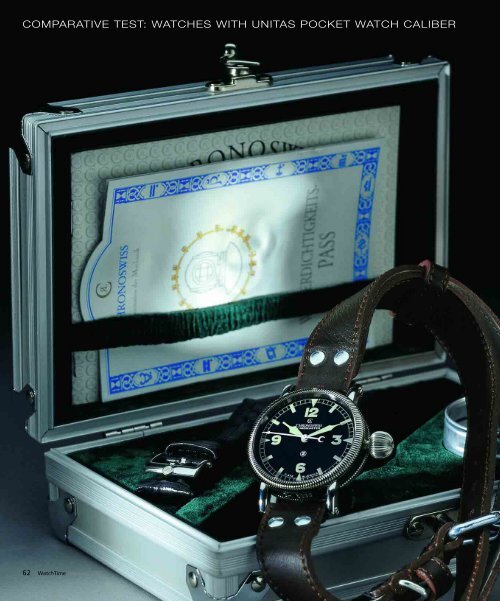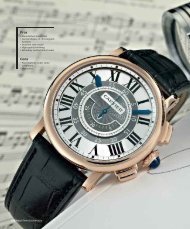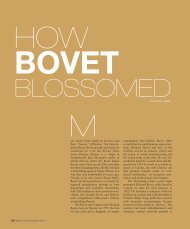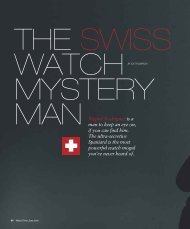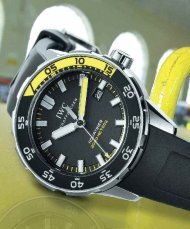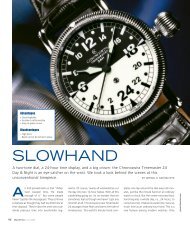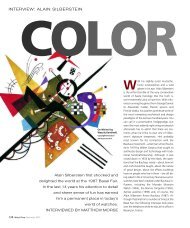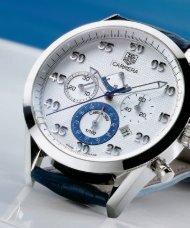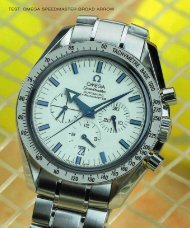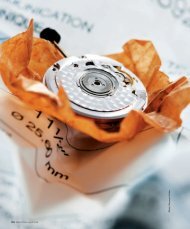comparative test: watches with unitas pocket watch caliber
comparative test: watches with unitas pocket watch caliber
comparative test: watches with unitas pocket watch caliber
Create successful ePaper yourself
Turn your PDF publications into a flip-book with our unique Google optimized e-Paper software.
COMPARATIVE TEST: WATCHES WITH UNITAS POCKET WATCH CALIBER<br />
62 WatchTime February 2002
Pocket to Wrist<br />
Sturdy and reliable, the<br />
Unitas <strong>pocket</strong> <strong>watch</strong> <strong>caliber</strong><br />
has become an increasingly<br />
popular choice for hand-wound<br />
wrist<strong><strong>watch</strong>es</strong>. WatchTime’s<br />
RÜDIGER BUCHER <strong>test</strong>ed<br />
three models powered<br />
by this the movement.<br />
February 2002 WatchTime 63
COMPARATIVE TEST: WATCHES WITH UNITAS POCKET WATCH CALIBER<br />
Above: On the movement<br />
side of the Chronoswiss<br />
<strong>caliber</strong> C 672, you<br />
can easily see the large,<br />
brass-colored transfer<br />
wheel. This wheel engages<br />
<strong>with</strong> the pinion of<br />
the center arbor, which is<br />
located beneath the additional<br />
bridge.<br />
When a <strong>watch</strong>maker wants to show a layman how a mechanical<br />
movement functions, he often pulls out a Unitas <strong>pocket</strong><br />
<strong>watch</strong> <strong>caliber</strong> 6497 to serve as the classic example. This <strong>caliber</strong><br />
has all of the essential rudimentary components, <strong>with</strong> no complications<br />
or a rotor, or even a date disk to obscure your view. The flow of energy<br />
from the barrel through the center-wheel, third-wheel, fourthwheel,<br />
escape-wheel, and all the accompanying intermediate gears, is<br />
readily visible here in what you might call its "primordial" form. Even an<br />
unpracticed eye finds it relatively easy to comprehend the workings of<br />
the device. In recent years, ever since large-format wrist<strong><strong>watch</strong>es</strong> have<br />
once again become popular, the <strong>caliber</strong> 6497 or 6498 which was originally<br />
conceived for <strong>pocket</strong> <strong><strong>watch</strong>es</strong> has been cropping up inside an<br />
ever-greater number of wrist<strong><strong>watch</strong>es</strong>.<br />
Anyone who owns a <strong>watch</strong> <strong>with</strong> a glass back can readily observe<br />
what happens when the <strong>watch</strong> is wound: the crown-wheel turns, propelling<br />
the large toothed wheel affixed to the barrel (known as either<br />
the "winding-wheel" or the "ratchet-wheel") <strong>with</strong> which the crownwheel<br />
meshes; at the same time, the little nosepiece of the click prevents<br />
the winding-wheel from slipping<br />
When a <strong>watch</strong>maker backwards. After these wheels have<br />
turned through a few rotations, the<br />
wants to show a layman<br />
balance begins to move. It soon finds<br />
how a mechanical movement<br />
works, he<br />
pace of five beats per second – a speed<br />
its rhythm and settles into a steady oscillation,<br />
rocking back and forth at a<br />
that is typical of this <strong>watch</strong>-movement,<br />
but rather leisurely compared to<br />
often pulls out a<br />
hand-wound Unitas <strong>pocket</strong><br />
<strong>watch</strong> <strong>caliber</strong>.<br />
the speeds of balances in other movements.<br />
If you look very carefully beneath<br />
the balance’s rim, you can even<br />
find part of the lever, whose little feet<br />
– technically known as "pallets" – tirelessly catch and release the teeth<br />
of the escape-wheel so that the entire clockwork advances at the correct<br />
speed and the fourth-wheel requires exactly one minute to rotate<br />
once around its own axis.<br />
With a diameter of 36 millimeters, the Unitas <strong>caliber</strong> is larger than<br />
many finished <strong><strong>watch</strong>es</strong>. Its generous dimensions have predestined it for<br />
Left: The Chronoswiss<br />
<strong>watch</strong>, its<br />
two wristbands<br />
and a little container<br />
full of spare<br />
parts are all delivered<br />
inside a spiffy<br />
presentation case<br />
An extra-large<br />
crown protrudes<br />
far from the case<br />
and contributes<br />
to the distinctive<br />
look of the<br />
Timemaster.<br />
64 WatchTime February 2002
service inside big, bold <strong><strong>watch</strong>es</strong> that emphasize good legibility and<br />
clear-cut designs. Furthermore, the <strong>caliber</strong>’s large size contributes to<br />
the stability of its rate.<br />
Gerd-Rüdiger Lang of Chronoswiss chose this movement for his new<br />
Timemaster, a giant <strong>watch</strong> (44 millimeters) <strong>with</strong> a correspondingly giant<br />
crown that immediately commands attention. As is typical of Lang’s creations,<br />
the Timemaster is less a <strong>watch</strong> than a work of art, one based<br />
DATA PAGE<br />
CHRONOSWISS TIMEMASTER<br />
Manufacturer: Chronoswiss Uhren GmbH,<br />
Elly-Staegmayr-Strasse 12, D-80999<br />
Munich<br />
Model: Timemaster<br />
Reference number: CH 6233<br />
Functions: Hours, minutes, central "sweep"<br />
seconds hand.<br />
Movement: Hand-wound Chronoswiss <strong>caliber</strong><br />
C. 672 (base <strong>caliber</strong> Unitas 6497-1); diameter<br />
= 36.6 mm; height = 5.4 mm; 18 jewels;<br />
18,000 beats per hour; Glucydur beryllium<br />
screw balance; self-compensating Nivarox 1<br />
balance-spring; Incabloc shock absorption;<br />
swan’s neck fine regulation; 50-hour power<br />
reserve (approx. 2 days, as indicated by the<br />
circled numeral "2" on the dial); plate <strong>with</strong><br />
circular graining on both sides; bridges <strong>with</strong><br />
Geneva Waves; stop-seconds function; each<br />
movement is individually numbered.<br />
Case: massive, 22-part, brushed and polished<br />
stainless steel case; fluted bezel rotates <strong>with</strong>out<br />
intervening notches in two directions and is<br />
marked <strong>with</strong> a Superluminova triangle; brushed<br />
case edge; screwed tube for the extra-large,<br />
onion-shaped crown; screwed strap lugs;<br />
patented Autobloc system; matte-black metal<br />
dial; luminous Superluminova C3 material on<br />
the hour-hand, minute-hand, numerals and indices;<br />
antireflective sapphire crystal; fully threaded<br />
screw-in back <strong>with</strong> antireflective viewing<br />
window; water-resistant to 10 atmospheres<br />
(100 meters).<br />
Wristband and clasp: Black crocodile-skin<br />
wristband; rapidly opening and closing clasp;<br />
wristband’s ends are reinforced <strong>with</strong> inner<br />
metal clips; pronged buckle; extra-long<br />
cowhide strap delivered along <strong>with</strong> the <strong>watch</strong>.<br />
Results of running <strong>test</strong> (deviations in<br />
seconds 24 hours):<br />
With/<strong>with</strong>out switched on chronograph function<br />
Dial up: +4<br />
Dial down: +4<br />
Crown up: +3<br />
Crown down: –2<br />
Crown left: +5<br />
Grea<strong>test</strong> deviation of rate: 7<br />
Average deviation: 3<br />
Average amplitude of the balance: 340°<br />
Dimensions: Diameter = 44 mm;<br />
height = 12.3 mm; weight = 101 grams<br />
(130 grams <strong>with</strong> professional wristband).<br />
Variants: Also available <strong>with</strong> luminous dial and<br />
black hands.<br />
Price: $3,750<br />
upon a logical and comprehensive concept.<br />
Conceived as an "outdoor" <strong>watch</strong>, it’s equipped<br />
<strong>with</strong> an extra-long cowhide strap of the sort<br />
found on old-fashioned deck-<strong><strong>watch</strong>es</strong>, so that<br />
the wearer can strap the <strong>watch</strong> to the outside of<br />
his jacket’s sleeve. People who prefer a more<br />
civilian look can easily remove the big cowhide<br />
strap and replace it <strong>with</strong> a very well crafted black<br />
crocodile-skin wristband. The <strong>watch</strong> and both<br />
straps are delivered inside a gorgeous box escorted<br />
by a little canister that’s filled <strong>with</strong> vital<br />
components: three insulators for the crown’s<br />
pipe and another one for the case back, as well<br />
as a second winding-stem and a spare balancestaff,<br />
just in case a nasty blow should happen to<br />
break the original ones. There’s also an extra<br />
mainspring, which is nice to have around if your<br />
clumsy gloved fingers should accidentally overwind<br />
the original mainspring until it snaps (not<br />
likely). Whether or not the typical Timemaster<br />
owner would dare to subject his <strong>watch</strong> to such<br />
extreme conditions is debatable, but the fact remains<br />
that so much practical attention to detail<br />
is a source of pleasure. Lang has thought of absolutely<br />
everything. For example, the straps are<br />
equipped <strong>with</strong> elaborately crafted quick-switch<br />
clasps that make it child’s play to change the<br />
wristbands. All you need to do is exert a bit of<br />
pressure and snap them into the lugs. This very<br />
convenient solution comes at a price, however:<br />
the ends of the strap, which are reinforced <strong>with</strong><br />
metal clips, have a fairly large amount of play.<br />
Now and then they tend to get jammed. And<br />
frequent interchanging subjects them to a lot of<br />
wear and tear, which threaten to decrease the<br />
longevity of these excellently crafted wristbands.<br />
Although the crown is large and protrudes<br />
uncommonly far from the edge of the case, you<br />
shouldn’t fear for its safety. Its pipe is firmly<br />
screwed to the case, which gives it plenty of<br />
strength. If it should accidentally break, it can<br />
readily be replaced. Furthermore, three O-ring<br />
insulators are fitted directly onto the pipe: this<br />
not only improves the <strong>watch</strong>’s resistance to penetration<br />
by water or dust, but also mean that the hands move especially<br />
smoothly when the crown is turned to adjust their positions – a very<br />
pleasant experience indeed!<br />
It was only logical to opt for the <strong>caliber</strong> 6497 as the motor for such a<br />
large and nostalgic wrist<strong>watch</strong> <strong>with</strong> such a prominent crown. Lang refined<br />
the original <strong>caliber</strong> by adding a swan’s neck fine regulation mechanism<br />
and decorated the <strong>caliber</strong>’s surfaces <strong>with</strong> various ornamental engravings.<br />
But that’s not all: he also made some<br />
interesting structural modifications. Because he<br />
wanted his Timemaster to offer the best possible<br />
legibility, Lang wasn’t interested in the small<br />
seconds subdial that this Unitas <strong>caliber</strong> typically<br />
supports. A cleverly constructed "detour"<br />
For everyday, indoor<br />
use: crocodile-skin<br />
wristband <strong>with</strong><br />
pronged buckle and<br />
the Chronoswiss<br />
logo (above).<br />
February 2002 WatchTime 65
COMPARATIVE TEST: WATCHES WITH UNITAS POCKET WATCH CALIBER<br />
mechanism transforms the small seconds subdial into a central<br />
"sweep" seconds-hand. To accomplish this modification, the <strong>caliber</strong> is<br />
equipped <strong>with</strong> an additional transfer wheel between the fourth-wheel<br />
and the pinion of the center-wheel. Propelled by the pinion of the thirdwheel,<br />
the transfer wheel rotates once every 7 1/2 minutes. It meshes<br />
<strong>with</strong> the pinion on the fourth-wheel’s staff, to which the seconds-hand<br />
is affixed. The other end of this staff is seated in an additional bridge; its<br />
pivot rotates in an 18th jewel (the unmodified 6497 has only 17 jewels).<br />
To ensure that the seconds-hand runs smoothly and <strong>with</strong>out flapping, a<br />
friction spring, which presses the transfer wheel upwards, is installed<br />
DATA PAGE<br />
MAURICE LACROIX MASTERPIECE<br />
Manufacturer: Maurice Lacroix,<br />
Brandschenkestraße 2, CH-8039 Zurich<br />
Model: Masterpiece Jour & Nuit<br />
Reference number: 07769-1602<br />
Functions: Hours, minutes, small seconds; day<br />
and night display.<br />
Movement: Hand-wound ML <strong>caliber</strong> 07, base<br />
<strong>caliber</strong> Unitas 6498-2; diameter = 36.6 mm;<br />
height = 5.6 mm; 17 jewels; 18,000 beats per<br />
hour; Glucydur screw balance; Nivarox 1<br />
balance-spring; Nivaflex 1 mainspring; Incabloc<br />
shock absorption; fine regulation; handdecorated<br />
<strong>with</strong> concentrically circular<br />
engraving, sun pattern and blued screws;<br />
no stop-seconds function.<br />
Case: Stainless steel and 18-karat yellow gold;<br />
sapphire crystal above dial; sapphire case back;<br />
sterling silver dial; blued hands; water-resistant<br />
to 3 atmospheres (30 meters).<br />
Wristband and clasp: Hand-sewn crocodileskin<br />
wristband <strong>with</strong> pronged buckle.<br />
Results of running <strong>test</strong> (deviations in<br />
seconds 24 hours):<br />
With/<strong>with</strong>out switched on chronograph function<br />
Dial up: 0<br />
Dial down: +4<br />
Crown up: +2<br />
Crown down: –3<br />
Crown left: +5<br />
Grea<strong>test</strong> deviation of rate: 8<br />
Average deviation: 2<br />
Average amplitude of the balance: 330°<br />
Dimensions: Diameter = 43 mm;<br />
height = 9 mm; weight = 73 grams<br />
Price: $2,950<br />
Maurice Lacroix<br />
uses the Caliber<br />
6498, which is built<br />
in a hunter-style<br />
construction.<br />
Very well crafted: the handsewn,<br />
crocodile-skin wristband<br />
and the clasp <strong>with</strong> the<br />
ML logo.<br />
By opting not to include a threaded,<br />
screw-in case back, Maurice Lacroix<br />
achieved a strikingly slender height<br />
for the Jour & Nuit.<br />
66 WatchTime February 2002
COMPARATIVE TEST: WATCHES WITH UNITAS POCKET WATCH CALIBER<br />
beneath the bridge. Unlike the movements in the other models that<br />
we’ll discuss later in this article, this Chronoswiss <strong>caliber</strong> is the only one<br />
<strong>with</strong> a stop-seconds function. This useful feature makes it easier to precisely<br />
set the <strong>watch</strong>. It can also be used to stop intervals of time to the<br />
second. The mechanism that supports the central seconds-hand is very<br />
sweet indeed, but there’s a drop of vinegar in the honey: the hand itself<br />
is not coated <strong>with</strong> luminous material. The hours and minutes are readily<br />
legible in the dark, but the owner will have to forego the pleasure of<br />
measuring nighttime intervals <strong>with</strong> to-the-second accuracy. Lang explains<br />
that he opted not to equip the seconds-hand <strong>with</strong> luminous material<br />
because the hand itself is so slender and because glow-in-thedark<br />
coating would have made the seconds-hand so heavy that it<br />
would no longer have run smoothly. For people who insist upon 100%<br />
legibility at all times, a version of the Timemaster is available <strong>with</strong> the<br />
dial completely coated <strong>with</strong> Superluminova, similar to <strong><strong>watch</strong>es</strong> used by<br />
submarine crews. The black hands, numerals and indices contrast clearly<br />
against the brightly luminous background.<br />
At Maurice Lacroix too, the <strong>watch</strong>makers weren’t content to use<br />
the standard Unitas <strong>caliber</strong> <strong>with</strong>out making a few changes of their<br />
own. The 6498 is built in so-called "savonnette" or "hunter" style,<br />
which means that the seconds stand at right angles to the crown. The<br />
people at Maurice Lacroix have modified the 6498 so that the hourwheel<br />
rotates only half as fast as it ordinarily does. Because it has twice<br />
as many teeth, it requires 24 hours to rotate once around its own axis.<br />
The result is a <strong>watch</strong> <strong>with</strong> an aesthetically successful 24-hour display.<br />
It takes some time to get used to it, but once you’ve grown accustomed<br />
to its face, you’ll be able to read it easily and instantly. The<br />
hour-hand extends in two directions from its central axis. One end<br />
bears a tiny sun, the other carries a little moon for the nighttime hours.<br />
The semi-circular hours scale spans the upper half of the solid silver<br />
dial and runs from 6 to 6. For example, when the sun-tipped end of<br />
the hand points to the 8, it’s eight o’-<br />
clock in the morning; if the moontipped<br />
end is above the 3, it’s three<br />
The dimensions of the<br />
Unitas (36 mm) have predestined<br />
it for service in-<br />
o’clock in the morning. At six p.m.,<br />
when the sun is leaving the 6 on the<br />
right-hand end calibrated scale, the<br />
side big, bold <strong><strong>watch</strong>es</strong><br />
moon is simultaneously arriving at the<br />
6 on the left-hand side.<br />
that emphasize legibility<br />
The design of the Masterpiece Jour<br />
and clear-cut designs.<br />
& Nuit (French for "day & night") differs<br />
radically from the design of the<br />
other two candidates. This <strong>watch</strong> isn’t<br />
meant to look sporty or to cope <strong>with</strong> rough blows. Aesthetics and<br />
style are the paramount factors here. The bicolor case <strong>with</strong> the solid<br />
gold bezel, the little onion-shaped crown <strong>with</strong> the golden cap, and<br />
above all the elegant design of the dial are the principal ingredients<br />
that combine to create the typical Maurice Lacroix Masterpiece look,<br />
which invariably suggests horological complications. The snap-on<br />
glass back helps to keep the <strong>watch</strong> beautifully slim and invites you to<br />
admire the movement, which boasts individually blued screws, goldplated<br />
faux chatons, and concentrically circular engravings on the<br />
bridges and cocks. The depression milled into the plate to accept the<br />
balance has been embellished <strong>with</strong> an attractive sun pattern. The<br />
<strong>watch</strong> makes do <strong>with</strong>out bridles because the movement fits snugly inside<br />
the case, all the way to the edge, where it’s held in place from behind<br />
by a pair of little screws. The screw balance oscillates at the standard<br />
pace of five beats per second.<br />
Panerai has made no structural modifications in the Unitas <strong>caliber</strong>.<br />
Nonetheless, the movement inside the Luminor Marina has some special<br />
attractions all its own. Whereas the majority of brands that use<br />
the Unitas 6497 or 6498 opt for the<br />
The Chronoswiss Timemaster<br />
is the only one of the<br />
<strong>caliber</strong> in its best-known form (<strong>with</strong><br />
an oscillating rate of 18,000 beats per<br />
hour), Panerai chose the variant <strong>with</strong><br />
three <strong>with</strong> a stop-seconds the speedier oscillation of 21,600<br />
beats per hour. In general, a fasterpaced<br />
balance tends to produce a<br />
function – a useful feature<br />
<strong>watch</strong> that runs at a more stable rate.<br />
that makes it easier to precisely<br />
set the <strong>watch</strong> this is the only one of our <strong>test</strong> candi-<br />
And a stable rate is essential, because<br />
dates that has been officially<br />
C.O.S.C.-certified as a chronometer.<br />
In our <strong>test</strong> on the Witschi timing machine,<br />
the Panerai <strong>watch</strong> outdid its competitors, albeit only by a nose.<br />
It was interesting to see that the <strong>caliber</strong> <strong>with</strong> 21,600 beats per hour<br />
showed the same characteristics as the one <strong>with</strong> 18,000 beats. Like<br />
the Chronoswiss and Maurice Lacroix timepieces, the Luminor Marina<br />
slipped into the "minus" ballpark when <strong>test</strong>ed in the "crown down"<br />
position. And like its two competitors, the Panerai <strong>watch</strong> ran fas<strong>test</strong><br />
ahead in the "crown left" position. The average amplitude (320°) remained<br />
relatively high, although not quite as high as in the other two<br />
models.<br />
The extravagance of the case’s design continues in the finissage of<br />
the movement. Rather than opting for classical Geneva Waves, the<br />
bridges and cocks are decorated <strong>with</strong> the word "Panerai" in a repetitious<br />
scheme that’s reminiscent of the one used by Cartier <strong>with</strong> its characteristic<br />
"C." Gold-plated faux chatons and blued screws round out<br />
the picture which, unfortunately, remains largely hidden to the casual<br />
observer because there’s no viewing window in the twelve-sided,<br />
screw-in back.<br />
Although Panerai cautiously approached the new launch in 1993<br />
and, after its takeover by the Richemont Concern, has partly focused its<br />
attention on limited-edition <strong><strong>watch</strong>es</strong>, the timepiece that’s colloquially<br />
known as "The Panerai" quickly established itself as a cult <strong>watch</strong>. In the<br />
<strong>watch</strong>’s Italian homeland, as well as in many other countries around the<br />
world, numerous fan clubs have been formed. Watch-lovers who join<br />
these clubs supply one another <strong>with</strong> detailed information about the science<br />
and technology embodied in current and historical models, and<br />
also draw up tables describing all of the models that Panerai ever produced.<br />
It was in 1936 that Mussolini commissioned the Florentine firm<br />
of Officine Panerai to produce highly (or rather "deeply") water-resistant<br />
<strong><strong>watch</strong>es</strong> for the Italian navy. In addition to being suitable for underwater<br />
use, Il Duce’s list of specifications also insisted that the <strong>watch</strong>-<br />
68 WatchTime February 2002
COMPARATIVE TEST: WATCHES WITH UNITAS POCKET WATCH CALIBER<br />
es offer optimal legibility, both in the dark and underwater. The hands<br />
and dials of the earliest Panerai <strong><strong>watch</strong>es</strong> were coated <strong>with</strong> strongly radioactive<br />
materials. These were soon replaced <strong>with</strong> less radioactive but<br />
nonetheless luminous tritium, and the<br />
name was correspondingly changed Because it has twice as<br />
from Radiomir to Luminor.<br />
many teeth, the Maurice<br />
The contemporary models combine<br />
the historical frogman myth <strong>with</strong> Lacroix’s hour-wheel requires<br />
24 hours to rotate<br />
urbane Italian elegance. This newly<br />
elegant role coincides <strong>with</strong> the delivery<br />
of a natural brown calfskin wristband<br />
along <strong>with</strong> the more military-<br />
once around its own axis.<br />
looking rubber strap. Because the The result is a 24-hour<br />
strap lugs are screwed, a tiny <strong>watch</strong>maker’s<br />
screwdriver is delivered inside<br />
display.<br />
the lacquered cherry wood box.<br />
Before pulling out the crown to adjust the hands, you must first release<br />
the safety lever and pivot it open. It’s also a good idea to release<br />
the lever before winding the <strong>watch</strong>. When the lever has been returned<br />
to its closed position, the crown is pressed about two millimeters<br />
Panerai has hidden its beautiful, chronometer-certified movement<br />
beneath a steel back.<br />
DATA PAGE<br />
PANERAI LUMINOR MARINA<br />
Manufacturer: Officine Panerai<br />
Model: Luminor Marina<br />
Reference number: PAM 00001<br />
Functions: Hours, minutes, small seconds.<br />
Movement: Hand-wound base <strong>caliber</strong> Unitas<br />
6497-2; diameter = 36 mm; height = 4.5 mm;<br />
21,600 beats per hour; 17 jewels; 41-hour<br />
power reserve; monometallic smooth-rimmed<br />
Glucydur balance; Incabloc shock absorption;<br />
decorated <strong>with</strong> "PANERAI" insignia; no stopseconds<br />
function; <strong>test</strong>ed chronometer <strong>with</strong><br />
C.O.S.C. certificate.<br />
Case: AISI 316 steel, polished; domed 3.5-mmthick<br />
antireflective sapphire crystal; black dial;<br />
hands, numerals and indices are all coated <strong>with</strong><br />
tritium; crown <strong>with</strong> locking lever; screw-down<br />
back; water-resistant to 300 meters; <strong>test</strong>ed to a<br />
maximum of 400 meters depth.<br />
Wristband and clasp: Brown calfskin <strong>with</strong><br />
pronged buckle.<br />
Results of running <strong>test</strong> (deviations in<br />
seconds 24 hours):<br />
Dial up: 2<br />
Dial down: 1<br />
Crown up: 2<br />
Crown down: –1<br />
Crown left: 5<br />
Grea<strong>test</strong> deviation of rate: 6<br />
Average deviation: 2<br />
Average amplitude of the balance: 320°<br />
Dimensions: Diameter = 44 mm;<br />
height = 16.8 mm; weight = 135 grams<br />
Special features: The model is also available for<br />
left-handers <strong>with</strong> its crown beside the "9."<br />
Price: $2,700<br />
The Luminor Marina<br />
can be recognized<br />
by the prominent<br />
protective lever<br />
that covers the<br />
crown. You need to<br />
unlatch the lever<br />
before you can set<br />
the <strong>watch</strong>’s hands.<br />
Sleek elegance: the<br />
Panerai wristband<br />
is made of natural<br />
brown calfskin.<br />
70 WatchTime February 2002
deeper into the case. This additional pressure makes a significant contribution<br />
to the <strong>watch</strong>’s ability to resist penetration by water: it’s water-resistant<br />
to 30 atmospheres. The slightly domed sapphire crystal is<br />
likewise crafted for deep submersion: it’s fully 3.5 millimeters thick.<br />
Although the no-nonsense Panerai looks quite massive, it’s relatively<br />
lightweight and quite pleasant to wear on its leather wristband. The<br />
case is painstakingly crafted: although it’s entirely <strong>with</strong>out sharp edges,<br />
it’s nonetheless clearly structured. Unfortunately, the glass overlaps a<br />
wee bit. If you’re puzzled about the meaning of the letters and numbers<br />
on the case back, here’s the answer, reading from top to bottom:<br />
the identification number of the case; the serial number of the <strong>watch</strong>;<br />
the number in the annual production; and the maximal atmospheric<br />
pressure (or depth) to which the <strong>watch</strong> remains water-resistant.<br />
The clearly designed dial and the decision to do <strong>with</strong>out a minutescircle,<br />
the hefty shape of the case, the obviously thick crystal, and last<br />
but not least, the distinctive locking lever over the crown struck a<br />
chord <strong>with</strong> <strong>watch</strong>-lovers when the Panerai was revived in the late<br />
1990s, and its continued popularity comes as no surprise.<br />
TEST RESULTS<br />
CHRONOSWISS TIMEMASTER<br />
Wristband and clasp (max. 10 points): 8<br />
Very good materials and craftsmanship; too<br />
much play in the band’s terminal inner clips;<br />
possibility of wearing out early.<br />
Operation (5): 5<br />
Optimal, even <strong>with</strong> gloves; setting the hands is<br />
an ultra-smooth experience.<br />
Case (10): 9<br />
Very high quality in all details, just as one<br />
always finds on Chronoswiss cases.<br />
Design (15): 13<br />
Unusual yet logical; successful combination of<br />
Chronoswiss design <strong>with</strong> the look of a deck<strong>watch</strong>.<br />
Legibility (5): 4<br />
We decided to subtract one point because<br />
the seconds-hand lacks tritium.<br />
Wearing comfort (10): 8<br />
Good; the large crown scarcely interferes.<br />
Movement (20): 14<br />
Intelligently improved, large-series <strong>caliber</strong><br />
<strong>with</strong> appealing embellishments.<br />
Results of running <strong>test</strong> (10): 8<br />
Good results <strong>with</strong> a very slight tendency to run<br />
fast.<br />
Overall value (15): 12<br />
Not inexpensive, but the price is justifiable for<br />
an extravagant <strong>watch</strong> <strong>with</strong> plenty of appealing<br />
extras.<br />
TOTAL: 81 points<br />
★★★★<br />
MAURICE LACROIX MASTERPIECE<br />
JOUR & NUIT<br />
Wristband and clasp (max. 10 points): 9<br />
Very well crafted, fully padded crocodile-skin<br />
wristband <strong>with</strong> typical bicolor ML clasp<br />
Operation (5): Good operation; the crown isn’t<br />
very large. 4<br />
Case (10): 8<br />
Well crafted, slender construction; the holes<br />
for the strap’s crosspieces are drilled very close<br />
at the ends of the lugs.<br />
Design (15): 12<br />
Typically elegant Masterpiece design <strong>with</strong> a<br />
stylish aura.<br />
Legibility (5): 3<br />
Takes some time to get used to, but after<br />
wards the owner can readily tell the time while<br />
the uninitiated remain pleasingly perplexed.<br />
Wearing comfort (10): 10<br />
Lies perfectly on the wrist; light weight and<br />
<strong>with</strong>out any sharp corners.<br />
Movement (20): 13<br />
Technically modified <strong>pocket</strong> <strong>watch</strong> <strong>caliber</strong> <strong>with</strong><br />
tasteful embellishment.<br />
Results of running <strong>test</strong> (10): 8<br />
Good, comparable <strong>with</strong> those achieved by the<br />
Chronoswiss <strong>watch</strong>.<br />
Overall value (15): 12<br />
A little pricey, but a rather unusual design.<br />
TOTAL: 79 points<br />
★★★<br />
PANERAI LUMINOR MARINA<br />
Wristband and clasp (max. 10 points): 8<br />
Strikingly wide wristband is sporty yet elegant.<br />
Operation (5): 5<br />
Simple and pleasant; locking lever is easy to<br />
open.<br />
Case (10): 8<br />
Massive and elaborately crafted, polished to a<br />
high-gloss finish.<br />
Design (15): 14<br />
Consistent, successful, readily recognizable; a<br />
trendsetter that will elicit admiration.<br />
Legibility (5): 4<br />
It’s difficult to read the minutes <strong>with</strong> precision,<br />
but the dial is perfectly legible in the dark.<br />
Wearing comfort (10): 8<br />
The <strong>watch</strong> is large and hefty, but not as heavy as<br />
it looks; no sharp corners; a good fit on the<br />
wrist.<br />
Movement (20): 12<br />
Few modifications have been made to the<br />
Unitas base <strong>caliber</strong>; chronometer quality;<br />
idiosyncratic decorative embellishment.<br />
Results of running <strong>test</strong> (10): 8<br />
Similar to but slightly better than those achieved<br />
by the Chronoswiss and ML <strong><strong>watch</strong>es</strong>.<br />
Overall value (15): 12<br />
An aficionado’s <strong>watch</strong> at an excellent price.<br />
TOTAL: 79 points<br />
★★★<br />
February 2002 WatchTime 71


